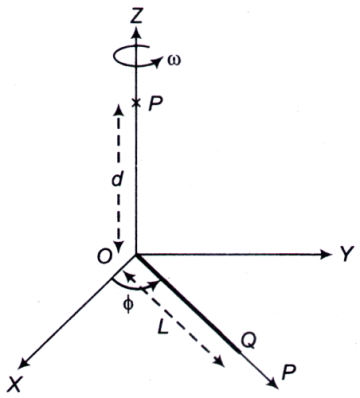61. A left circularly polarized light beam of wavelength 600 nm is incident on a crystal of thickness d and propagates perpendicular to its optic axis. The ordinary and extraordinary refractive indices of the crystal are no = 1.54 and ne and = 1.55 respectively. The emergent light will be right circularly polarized, if d is
62. An atom with net magnetic moment $$\overrightarrow \mu $$ and net angular momentum $$\overrightarrow {\bf{L}} \left( {\overrightarrow \mu = \gamma \overrightarrow {\bf{L}} } \right)$$ is kept in a uniform magnetic induction $$\overrightarrow {\bf{B}} = {B_0}{\bf{\hat k}}.$$ The magnetic moment $$\overrightarrow \mu \left( { = {\mu _x}} \right)$$ is
63. When liquid oxygen is poured down close to a strong bar magnet, the oxygen stream is
64. The work done in bringing a charge +q from infinity in free space, to a position at a distance d in front of a semiinfinite grounded metal surface is
65. A rod of length L with uniform charge density $$\lambda $$ per unit length is in the XY-plane and rotating about Z-axis passing through one of its edge with an angular
velocity $$\overrightarrow \omega $$ as shown in the figure below. $$\left( {{\bf{\hat r}},\,\hat \phi ,\,{\bf{\hat z}}} \right)$$ refer to the unit vectors at Q, $$\overrightarrow {\bf{A}} $$ is the vector potential at a distance d from the origin O along Z-axis for d ≪ L and $$\overrightarrow {\bf{J}} $$ is the current density due to the motion of the rod. Which one of the following statements is correct?


66. A dielectric sphere is placed in a uniform electric field directed along the positive Y-axis. Which one of the following represents the correct equipotential surfaces?
67. Match the following:
List-I
List-II
P. Rest mass
1. Timelike vector
Q. Charge
2. Lorentz invariant
R. Four-momentum
3. Tensor of rank 2
S. Electromagnetic field
4. Conserved and Lorentz invariant
| List-I | List-II |
| P. Rest mass | 1. Timelike vector |
| Q. Charge | 2. Lorentz invariant |
| R. Four-momentum | 3. Tensor of rank 2 |
| S. Electromagnetic field | 4. Conserved and Lorentz invariant |
68. A copper wire of uniform cross-sectional area 1.0 × 0-6 m2 carries a current of 1 A. Assuming that each copper atom contributes one electron to the electron gas, the drift velocity of the free electrons (density of copper is 8.94 × 103 kg/m3 and its atomic mass is 1.05 × 10-25 kg) is
69. The electromagnetic field due to a point charge must be described by Lienard Weichert potentials, when
70. Four point charges are placed in a plane at the following positions +Q at (1, 0), -Q at (-1, 0), + Q at (0, 1) and -Q at (0, -1).
At large distances the electrostatic potential due to this charge distribution will be dominated by the
At large distances the electrostatic potential due to this charge distribution will be dominated by the
